Grumman F6F Hellcat, ch.2
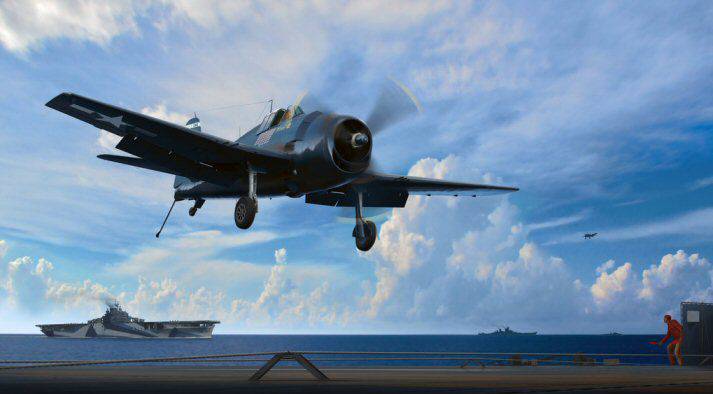
We continue to get acquainted with history the creation of the famous American naval fighter Grumman F6F Hellcat.
Modification F6F-5
At the end of January 1944, one specially prepared fighter F6F-3, which has increased tactical and technical characteristics, developed the speed 6405 km / h at the height of 660 m on a horizontal stretch. Based on this machine and taking into account the experience gained during the production of all previous versions of F6F-3, a modification F6F-5 was developed. The first serial F6F-5 took off 4 on April 1944. Externally, the new machine was almost no different from its predecessor. The main changes were to increase the strength of the fuselage tail section in order to prevent its deformation in the stabilizer area, which was inherent in F6F-3, enhanced booking (up to 110 kg), as well as installing under-wing bomb racks and missile guides of “zero start” (outboard weapon weight increased up to 1542 kg). The aerodynamics of the airframe has become more perfect. Slightly changed engine hood. The cockpit canopy of the pilot's cockpit was refined: three armored glass were installed instead of one central. Most of the cars (except for the first series F6F-5) lacked transparent "ears" of the rear view behind the pilot's seat. Dashboards had a red backlight. All the vehicles “regularly” were equipped with a radar wing assembly. Part of the aircraft was armed with two 20-mm cannons with 250 rounds of ammunition per barrel and four 12,7-mm machine guns with 400 ammunition per barrel of ammunition. However, the standard was the option of weapons with six 12,7-mm machine guns. In fact, the F6F-5 has become a multipurpose fighter capable of operating day and night, and in different weather conditions.
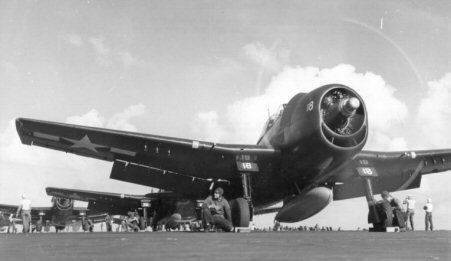
The F6F-5 was equipped with a Pratt-Whitney R-2800-10W engine with a direct injection of water-methanol mixture into the cylinders. Tests have shown that in comparison with the F6F-3, horizontal flight speed increased by 28 km / h, although the climb rate remained at the same level. Due to the presence of trimmers and adjustable bent plates on both ailerons (the position of the plate on the left aileron was regulated from the cockpit), the roll speed increased, which improved the maneuverability of the aircraft. In the conditions of mass production and the presence of low-skilled personnel it is difficult to achieve a high symmetry of the design of the apparatus, entailing specific, individual behavior in the air of each aircraft, which the pilot must constantly parry the controls. Adjustable plates were installed on controlled surfaces and served to balance the behavior of the aircraft in flight.
We have already noted that the production of aircraft at the Grumman company was organized extremely efficiently, which allowed in November 1943 to increase the production of Hellcat up to 400 aircraft a month. The concern for staff on the part of company management was unprecedented. Free medical care, a nursery and an "extension" for children, a friendly atmosphere, a good salary - all this contributed to the fact that the staff turnover did not exceed 1%. At the end of 1944, the productivity of the company's factories reached the turn of 700 F6F aircraft per month. Marine Command aviation was forced to ask to reduce the production of aircraft to 600 per month, since flight schools could not provide the required number of pilots. During the manufacturing process, the cost of one aircraft decreased from $ 50000 to $ 35000 (the price of the Corsair was 30% higher).
Production of F6F-5 was completed in November 1945. A total of 7870 copies of F6F-5, F6F-5N, F6F-5E and F6F-5P were released. The end of production of the F6F-5 simultaneously meant the completion of the general release of the Hellcat fighters.
F6F-5N
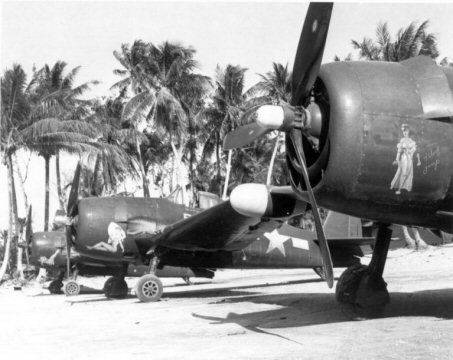
The night version of the fighter F6F-5, equipped with a radar Sperry AN / APS-6. The antenna of the radar was located in the gondola under the right console. The armament of most of the machines in this version consisted of two Colt-Browning M20 X-guns and four Colt-Browning M2 12,7-mm guns. At least two aircraft of this version were converted to be installed under the left console of the wing of the searchlight, which is used to detect and identify submarines in surface position. A total of 2 machines were released.
F6F-5E
Modification of the night fighter with Westinghouse AN / APS-4 radar. The composition of the equipment is identical to F6F-3E.
F6F-5P
The reconnaissance version was equipped with a long-focus camera installed at the bottom of the fuselage behind the cockpit. The camera was intended to conduct high-altitude intelligence. Some aircraft of this modification did not carry weapons.
Special modifications.
A small part of the serial fighter aircraft F6F-3 and F6F-5 was converted into flying targets under the designation F6F-3K and F6F-5K. These aircraft could be remotely controlled both from land and ship control stations, as well as from another aircraft. Some of these cars carried additional fuel tanks located on the wingtips. In 1946, a part of the aircraft F6F-3K was used in research during nuclear explosions on the Bikini Atoll. In 1952, when conducting combat operations in Korea, unmanned F6F-5K, armed with a 908 kg bomb and television cameras in underwing containers, were used to destroy large targets. In 1949-58 A small part of the aircraft of a special modification was used to research the remote flight control of the F6F-5K fighter.
Combat application.
16 January 1943. The first few F6F-3 serial vehicles were sent to the squadron of the VF-9 daytime fighter aircraft, based at that time on the Long Islandland escort aircraft, for military and operational tests. Intensive flights with elements of combat use did not reveal any significant problems with Hellcats (although one of the pilots had to accidentally plant a car in the forest due to engine failure, as a result of which it was completely broken, but the pilot was not injured). It turned out that a significant wing area and a large aircraft weight contribute to a high stability in the behavior of the machine during the landing mode, with the result that the landing speed even turned out to be 8 km / h less than that of the Wildcat. By 13 March 1943 VF-9 was completely re-equipped with “Hellcats” and transferred to the aircraft carrier “Essex” in order to familiarize and retrain combat pilots to the new fighter.
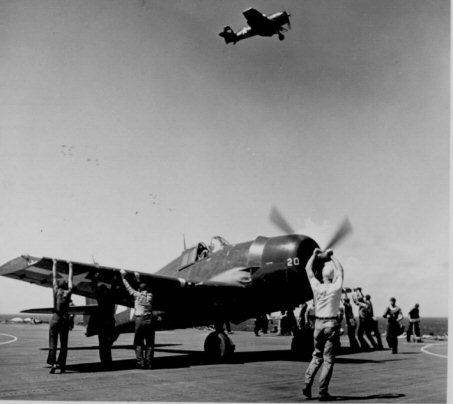
In the middle of 1943, the 9-I carrier group, consisting of the attack aircraft carrier Essex and Yorktown, and the Independés light aircraft carrier, the pilots of which were the first to master the F6F-3 and had 50 flying hours, were sent to Marcus Island located 700 miles southeast of Japan, to support the upcoming landing operation.
Early in the morning of 31 in August, 1943 was a large group of aircraft launched from aircraft carriers and headed for Marcus Island. The target for the strike was a Japanese airfield, which posed a real threat to the landing operation. The Hellcat fighters from VF-5 (Yorktown) and VF-9 (Essex) were assigned to escort bombers and attack aircraft. Even on the approach to the island, they fired upon several Japanese guard ships - these were the first real strikes of F6F against the enemy. The airfield on the island was well protected by anti-aircraft guns, so the Hellcats were used to suppress them, especially since the Japanese did not have time to lift their fighters into the air. In the most difficult conditions, the Japanese anti-aircraft gunners showed their best and shot down several American planes, among which were two Hellcat from VF-5. The pilot of one of them managed to reach his cruiser and splash down next to him. Sailors quickly raised the pilot on board.
The next day, during the invasion of Americans on Baker Island, the pilots F6F-3 from the flight crew of the light carrier Belleu Wood and the light aircraft carrier Princeton announced the destruction of three heavy four-engine flying boats Emily, which were the first air victories, gained on the Hellcats.
Everyone was looking forward to meeting with the legendary Japanese carrier-based fighter Zero. 5 October 1943. Americans landed on Wake Island. This operation was covered from the air by fighter aircraft attack aircraft carriers Essex, Yorktown, Lexington and Cowens. Before departure, the commander of the aviation group promised to give the first pilot, shot down a Japanese plane, a bottle of five-star Old Crow whiskey.
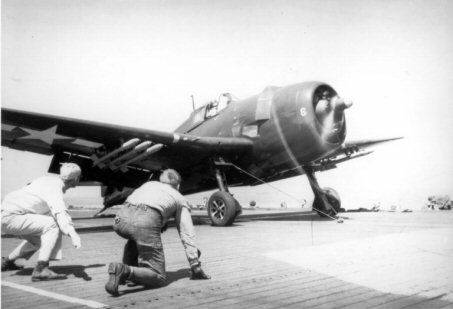
When 50 was left for the target, the Japanese spotted a group of 47 “Hellcat” with a radar and raised their Xerox Zero into the 27. The first Japanese were discovered by a young pilot, Robert Dunknkan from the Yorktown aircraft carrier, and immediately attacked the nearest Zero, concentrating fire on his cockpit. The enemy's aircraft flared, brightly illuminating the still gloomy morning sky, and went down. Without losing time, Dunnkan quickly went to the tail of the next Japanese and gave a long line - he began to smoke strongly, fell on the wing and almost vertically collapsed in the water. Returning to his aircraft carrier, Dunnkan was deservedly awarded a bottle of "Old Crow."
In early November, 1943 began an air offensive by major American aircraft carrier forces on the most important naval base of the Japanese, Rabaul. 5 November 52 Hellcat was covered by bombers and torpedo bombers in an attack on this port. Around 70 Japanese fighters were lifted into the air to intercept Americans. While diving bombers and torpedo bombers, going into the attack, did a circle over the island, the Hellcats formed a dense protective veil. In a fierce air battle, 25 Japanese were shot down (and, presumably, still 25 aircraft). American losses amounted to 10 vehicles (two fighters and eight bombers), most of which were shot down by anti-aircraft artillery.
November 11 was repeated air attack Rabaul. In response, the Japanese expelled 120 aircraft (including 67 fighters) from the American aircraft carrier, which were met by the Hellcats on the way to aircraft carriers. During the air battle, 30 Japanese aircraft were shot down; American losses accounted for 11 fighters. Such an outcome of the battle vividly illustrated the superiority of the new American fighters and the increased level of training of American pilots.
Hellcat pilots gained major victories during Japanese attacks fleetbased on Kwajalein, and a raid on the airfield located on the island of Roy. The total number of enemy aircraft shot down - 91 aircraft. On December 4, in aerial combat, the Americans shot down 28 of the 50 enemy aircraft, losing only two of their own.
The appearance of "Hellcat" was for the Japanese a complete surprise. It happened that young Japanese pilots would get out of the battle or simply leave their cars, seeing the characteristic silhouette of the American fighter on the horizon.
By the end of 1943, the Hellcat became the main fighter aircraft of the US Navy, based on all types of aircraft carriers operating in the Pacific. At this time, the battle for the Gilbert Islands broke out, during which the Hellcats shot down near 100 enemy aircraft. In total, for 1943 (for five months), the Hellcat pilots destroyed 230 Japanese aircraft, with the loss of their 30 machines.
Hellcat received high praise from the mouth of Japanese pilots. “During the fighting on the Gilbert Islands in September 1943, the Grumman F6F Hellcat fighter debuted. This aircraft carrier fighter was one of the most formidable opponents of the Zero. The first reports of the new Grumman fighters indicated that his project was influenced by a careful study by the Americans of the Zero captured on the Aleutian Islands. To some extent, the Americans adopted even the practice of saving weight, although this was completely atypical for American aircraft.
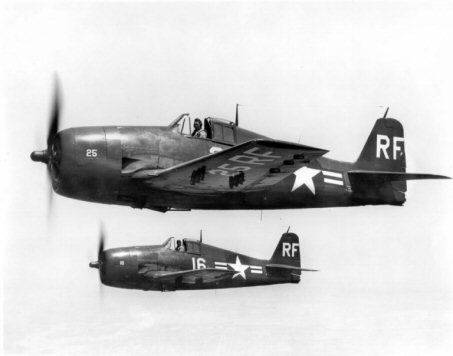
There is no doubt that the new "Hellcat" surpassed the "Zero" in almost all characteristics, except for maneuverability and flight range. He quickly gained altitude and dived faster, could fly at a higher altitude, had a protective tanks and booking. Like the Wildcat and the Corsair, the new Hellcat was armed with six 12,7-mm machine guns. However, he carried much more ammunition than other fighters.
Of all the fighters of the Pacific theater of war, only Hellcat could stand up for itself in a fighter fight. The Americans claimed that with the advent of the Hellcat, the American fleet regained its ability to conduct close combat with the Zero. The favorite maneuver of the Americans was a gentle dive of a pair of fighters at high speed. If “Zero” fell within the reach of enemy machine guns, “Hellcats” opened fire, skipped past and left with a U-turn. ” In fights with maneuverable "Zero" pilots "Hellcat", using high horizontal speed and powerful weapons, were able to destroy the enemy, not allowing themselves to engage in a dangerous "carousel" long air combat.
The baptism of night fighters F6F-3N occurred in February 1944, when an aircraft from the VF (N) -76 structure of the Yorktown aircraft carrier intercepted the Kate bomber carrying the night attack on the Interpid aircraft carrier.
In February, 1944. Americans launched a strike against a well-fortified Truk fortress, sometimes called Gibraltar of the Pacific, by aircraft carrier forces. During the two-day 129 raid, enemy aircraft were destroyed in the air, 82 on the ground and 70 was damaged. “Hellcats” demonstrated high combat qualities and exceptional ease of piloting. In many ways, the legendary reputation of the Hellcat was based on the high reliability of the engine and the main units, as well as on good landing characteristics. One day, the fighters of the aircraft carrier Cowens returned from their combat missions to cover a group of ships in complete darkness. Despite the fact that none of the pilots had any experience of night landings on an aircraft carrier, all the planes landed safely on the Cowens.
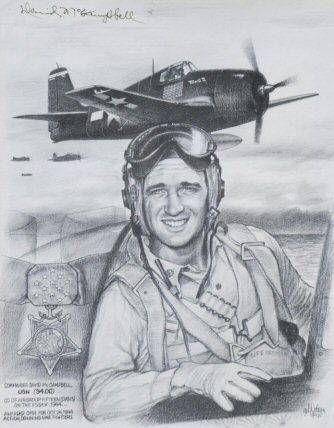 At dawn 30 March 1944, the Americans struck a crushing blow to the Palau Islands. Fierce fights broke out in the air. Opponent lost about 150 aircraft. US casualties accounted for 25 aircraft. The Hellcat pilots had a convincing advantage, both in tactics and in individual skills.
At dawn 30 March 1944, the Americans struck a crushing blow to the Palau Islands. Fierce fights broke out in the air. Opponent lost about 150 aircraft. US casualties accounted for 25 aircraft. The Hellcat pilots had a convincing advantage, both in tactics and in individual skills.One of the most famous American pilots who fought on the Hellcat was David McCampbell. He was born on January 16 1910 in Bessemer, Alabama. As a young man, he was not accepted into the Stanton Military School: Army doctors found out that the future best fighter pilot of the US Navy had "vision problems." Attempting to become a pilot David repeated 1936 in June. By this time, McCampbell had a lot to do: finish technology school, naval school, work in a construction company, at a branch of the Douglas aviation company, serve as a naval gunner observer in the rank of junior lieutenant.
And again the medical commission rejected his candidacy. McCampbell did not give up this time either. He turned to a civilian doctor, who recognized his vision as sufficient for service in aviation. Finally, on the third attempt, the stubborn “Yankee” was accepted and transferred to the Pensacoli air base in Florida, where he was trained in flight business. 23 April 1938. He was awarded the title of sea pilot.
David's new destination was the aircraft carrier Ranger, where his squadron VF-4 was based. After two years of service, he was transferred to the aircraft carrier "Wasp", but not a pilot, but a deck officer landing aircraft. After the death of the ship in the Coral Sea, McCampbell served at the Navy air base in Jacksonville, and later at the Melbourne base in Florida.
In September 1943 Lieutenant Komondor David McCampbell was appointed commander of the VF-15 squadron based on the Essex aircraft carrier, and later commander of the aircraft carrier CAG 15. In the spring of 1944, Commander McCampbell began to fight again, now a pilot. By then, David had 2000 flying hours, of which 600 hours were on the Hellcat F6F-3 fighter.
11 June 1944. He scored his first victory by shooting down the A6М2 Zero fighter over Saipan Island, and after 12 days he had already shot down 11,5 aircraft. Particularly successful was the day of June 19, when the pilot shot down six bombers in the morning, and added two more Zero fighters in the second. In late summer, the US carrier fleet was aimed at the liberation of the Philippines. Deck aircraft received new fighter aircraft F6F-5. These new aircraft entered the division VF-15. On the morning of October 24, 1944 was a large group of Japanese aircraft - 20 bombers under cover of 40 fighters took off into the air to strike at American ships. The target was not very far away when they met seven American fighters east of the island of Polilo (Leyte Gulf region). Seeing in front of them a handful of enemy planes, the Japanese pilots probably did not consider this obstacle impassable, but ... they were not lucky that day. American fighters were led by Commander McCampbell, the first fleet pilot who overcame the 20 line for downed aircraft. Having detached five of his pilots to destroy Japanese bombers, he, along with Lieutenant Roy Rushingham, attacked escort fighters.
Two against forty, no chance ... but the American pilots not only survived, which is surprising in itself, but also managed to destroy the 16 Japanese fighters! Of these, nine chalked up McCampbell. This record - nine downed aircraft in one sortie was not surpassed by any American pilot. For this fight, McCampbell was awarded the highest award - the Medal of Honor of Congress.
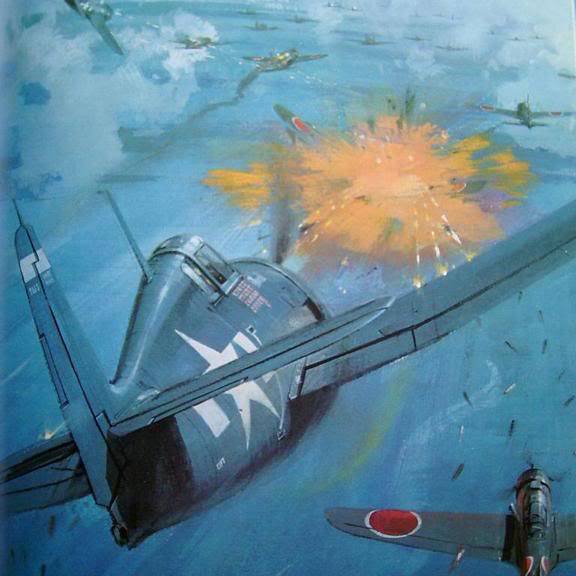
In fierce air battles in the Philippines, McCampbell shot down an 22,5 aircraft, the last of them, the Ki.43 fighter, 14, November 1944, and 15, November, the CAG 15 was set aside for rest in the United States. With his 34 victories, McCampbell became not only the most efficient Navy pilot, but also the only American who shot down over five enemy aircraft in one day twice. In addition, he destroyed 21 Japanese aircraft on the ground.
David's commanding qualities were also high - the VF-15 squadron became the most productive unit of American aviation: in air battles its pilots shot down the 310 of enemy aircraft, and the entire aircraft carrier group CAG 15 destroyed 348 aircraft on the ground, sank the ships with a total tonnage of 296500 gross, participated in the destruction of the superlinker "Musashi", three aircraft carriers and a heavy cruiser. After the war, McCampbell served in various command positions in the US Army.
11 June 1944 began fighting for the island of Saipan, the largest of the Mariana Islands. In the afternoon, the 58-e operational carrier-carrier connection sent air groups against the islands of Saipan, Tinian and Guam. For the Japanese, the appearance of American aircraft was a complete surprise. During the four days of air combat, 147 enemy planes were destroyed, about a third of those stationed in the area. American casualties were 11 Hellcat and six pilots.
15 and 16 were hit on enemy airfields on Iwo Jima and Titijima, located 600 miles from Japan. The Hellcats belonging to VF-1 from Yorktown, VF-2 from Essex and VF-50 from Batana provided air cover and direct support for the landing party. They started in bad weather about 400 km from Iwo Jima. Each of them carried a single 250-kg bomb on board. “Hellcats” from the carrier Belleu Wood remained to protect the 58 th aircraft carrier task force. The aim of the strike force was 122 Japanese aircraft, based at the airport Iwo Jima. However, the Japanese radar station found a strike group consisting of an 51 plane, and American planes were waiting for the target near the 80 Zero. 40 Japanese fighters were above the clouds, the rest below. When the 15 "Hellcat" from VF-2 pierced a layer of clouds, they were immediately attacked by "Zero" from the sun. The 16 aircraft VF-1 flying lower were attacked by a group of Japanese aircraft, among which was Saburo Sakai. Six American planes were shot down (four - K. Muto and two - S. Sakai) at the price of the 37 Zero. Another 34 Japanese aircraft were destroyed by “Hellcats” and shipboard anti-aircraft artillery fire while repelling a Japanese torpedo bombers counterattack on American ships. Thus, over the course of one morning, the Japanese air force on Iwo Jima decreased by 50%. After the aircraft carrier Franklin replaced the 58 th operational group, the new F6F-5 entered the battlefield. But it was only a prelude to the last carrier battle of the second world war.
The Mariana Islands, Saipan, Tynan and Guam, located almost 600 miles south of Iwo Jima, were not of great strategic importance, but soaring from there, the B-29 Bombers Superfortres could attack Japan. Therefore, both the Americans and the Japanese were determined: the first to seize the islands, the second to defend their possessions. According to the Japanese command, the defeat of the 58 operational connection would not only prevent the islands from invading, but would completely exclude any offensive actions by the Americans in the area for some time. According to the plan of Admiral Ozawa, it was assumed that the 58-e operational connection, when approaching from the west, weakened by air strikes from the islands of Guam and Truk, would be finally defeated by its new aircraft carriers that had 430 aircraft. However, when the 19 of June 1944 from the Japanese aircraft carriers, the airplanes of the first shock wave (69 airplanes) took to the air, the first to be met by the Hellcat of the 58 th operational connection. In an air battle, the enemy's 42 aircraft were shot down. A few hours later, the Japanese repeated the attempt to break through to American ships. 128 aircraft were raised into the air. After the battle, the 97 machines did not return to the Japanese aircraft carriers. In the evening, there was another air battle, during which 75 Japanese aircraft were destroyed. Thus, in one day the Americans (58-e and 2-e operative connections) destroyed 297 aircraft carrier aircraft, and only about 400 (here it is necessary to take into account the loss of Japanese coast-based aircraft). This battle in the American literature is often called the "Great Pheasant Hunt." Japanese aircraft carrier ceased to exist. In the future, Japan could no longer train enough deck pilots.
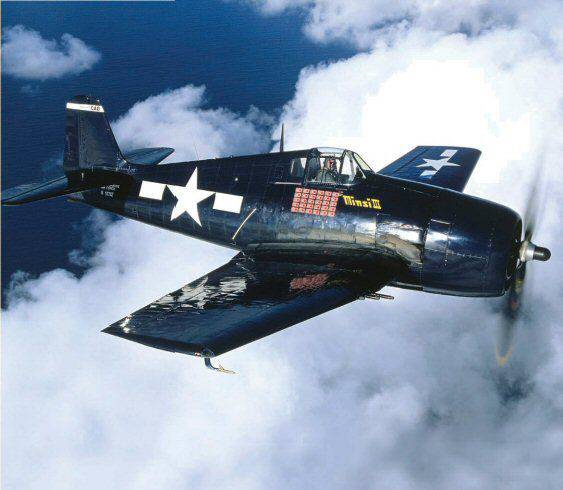
When the 20 of June Ozawa turned back in the afternoon, only a small part of the aircraft remained on board its aircraft carriers. The Americans decided to finish it, but acted extremely unfortunate. Despite the fact that most of the pilots did not have night flight experience, a mixed group of 216 58 -s of the operational connection flew to the combat mission already at dusk. The Japanese group was at the limit of the range of the aircraft, so the attack was carried out already in the dark. In an air battle, a Japanese fighter jet was shot down by 22, the Americans' losses were 20 aircraft. Return to aircraft carriers occurred in bad weather conditions, the situation was aggravated by a strong headwind. As a result of a crash into the sea (fuel ended) and emergency landings on the decks of aircraft carriers, 80 aircraft were lost, while the deck-based reconnaissance bomber Curtiss SB2C Helldiver suffered the highest losses (about 90%) and Hellcats the lowest. About 80% of the pilots were saved. This illiterately performed operation blurred the impression of the brilliant victory gained by the Hellcats in 19 June air battles.
Even in the daytime, in normal conditions, landing on the deck of an aircraft carrier was not an easy task and required precise observance of certain rules and calculation. After receiving permission to land, the Hellcat approached an aircraft carrier at a speed of 204 km / h. The chassis, landing hook and flaps are released, the tail wheel is blocked, the mixture is in the “auto-rich” position, the supercharger is “neutral”, the propeller is “small step”, the cooling system blinds are “closed”.
After the last turning, before landing, the pilot had to keep the speed of 148 km / h. Now the landing signalman required a lot of attention from the pilot. For a better overview, the final stage of the landing approach was usually performed on a gentle reversal. Downward three-degree engine tilting was another advantage of the Hellcat. On American aircraft carriers, the signaling officer showed the pilot the angle of planning the aircraft in relation to the aircraft carrier. On British aircraft carriers, the signaling officer gave corrective orders.
The pilot learned about the correct approach to the position of the hands of the signaling officer, who in this case held the signal discs horizontally. If the call was wrong, the signaling officer kept them crossed over his head. When the plane was at a height of two meters above the deck, the signaling officer showed the signal “Trim!”, Crossing his arms below. The pilot immediately turned off the engine and pulled the handle towards himself. The plane lost speed, boarded the deck and stopped by a landing cable with a hydraulic brake.
If the landing speed was lower than 139 km / h, the plane usually first hit the deck with its tail wheel and jumped (“goat”), increasing the angle of attack. At higher landing speeds, the deck was too short for both landing and re-take-off. The third possibility to break when landing was that the aircraft design could not withstand excessive loads when hooking on the landing cable, breaking off in the tail section.
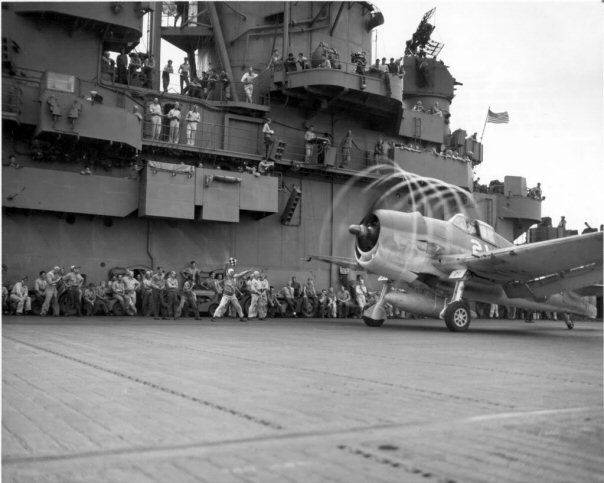
Landing characteristics are largely determined by the location of the wing. The wing of the Hellcat was not perfect in terms of aerodynamics. At the same time, it, unlike the Sifire, the Sea Harrikey, and the Corsair, whose low-lying wing created an air cushion between the airplane and the deck, did not have this disadvantage. The combination of a successful wing design with a strong, well absorbing landing gear creates ideal landing conditions for the aircraft. This was an important advantage, since the accidents reduced the combat capabilities of the aircraft carrier. Time was priceless. If, for example, each landing of the aircraft took one minute, then the closing plane would have to wait for its turn 1,5 hours.
American troops conducting amphibious operations, landed, as a rule, with the support of naval artillery and aircraft. Since the functions of the fighter-bomber were usually assigned to the Hellcat, the danger of suffering from the fire of the Japanese anti-aircraft artillery was also very high. In order to avoid high losses, the pilots were recommended to attack with the greatest possible speed, using the anti-aircraft maneuver and never to re-enter from the same direction.
Since the American pilots fought by so-called. combat rotational scheme, it often happened that during their stay in the battlefield the pilots did not see Japanese aircraft at all. So, for example, VF-1 was in the area of hostilities only from December 1943 to January 1944 on the island of Tarawa and in June-July 1944 on the Yorktown aircraft carrier.
The F6F-5 and F6F-5N fighters began combat service at the end of the summer of 1944, quickly changing aircraft of previous modifications. During the attack on Taiwan in October, 1944 was the first to select the Independence aircraft carrier for combat missions. Based on it, the 14 airplanes of the VF (N) -41 division won their first victories on the night of 12 on October 13, shooting down five G4M "Betty" bombers.
In December 1944, the F6F-5 comparative tests with the captured A6M5 Zero were conducted. Tests have shown that Hellcat has a greater horizontal speed at all altitudes: at 66 km / h at sea level, at 100 km / h at altitude 4572 m and at 106 km / h at altitude 9144 m. However, Zero had the best on 3 m / s, the rate of climb at altitudes below 2743 m, up to a height of 4267 m, the rate of climb F6F-5 and A6M5 were about the same, higher than Hellcat was better on 2,5 m / s. “Japanese” had the best roll speed, especially at speeds up to 370 km / h, at high speeds (under high overload conditions) was preferable to “Hellcat”. In the steady bend, A6M5 had a significant advantage, especially at low speeds and altitudes (3,5 full bends gave him an advantage in 1 turnaround). At the same time, the Hellcat was better at diving. Therefore, American pilots were advised to never turn more than 90 degrees or make loops. The best way to “drop” “Zero” from the tail was considered a coup through the wing and dive.
Since February 1945, the US Navy's fighter units have begun to support the Marine Corps units based on escort aircraft carriers. Each Marine unit was armed with eight F6F-5 fighter jets and two F6F-5P fighter jets. 15 August 1945. Six aircraft from the VF-88 of the aircraft carrier Yorktown intercepted the 12 Zero fighter aircraft, knocking down eight of them and losing four of their own. This was the last combat operation of the Hellcat fighters during the Second World War.
The results of the combat use of fighter F6F of all modifications proved to be extremely effective. During the two-year service, the Hellcat pilots recorded 5156 shot down Japanese aircraft in air battles (ship-based 4947 and ground-based 209) at the cost of their own 270, which is the 19: 1 ratio. Particularly effective were their actions to intercept kamikaze attacks and when accompanied by bombers during raids on the continent. 305 pilots flying F6F have earned the high ace title.
During the Second World War, the Hellcat fighters armed 59 fighter squadrons, 10 night fighters and 7 fighter bomber squadrons of the US Navy. In addition, fighters "Hellketa" were in service with five night and one day fighter units of the United States Marine Corps.
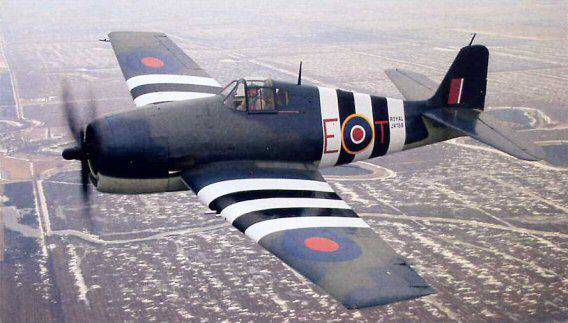
It is impossible not to recall the fighter "Hellcat", which was in service with the naval forces of Great Britain. Under Lend-Lease contracts, Britain received an F1182F Hellcat 6. The deliveries of F6F-3 (252 machines) began in March of 1943 under the original name “Gannet”, which was soon abandoned in favor of Hellcat F.Mk.I. The first aircraft entered the test centers, training units and (at the beginning of the summer of 1943) two squadrons - 800 and 804.
After intensive training of flight and technical personnel in December 1943, both squadrons relocated to the aircraft carrier "Imperial". As part of the 7 Fighter Wing, they performed the task of escorting convoys following the North Atlantic, and practically did not participate in air battles with enemy aircraft. In March, 1944, the aircraft carrier Imperial, returned to the metropolis to take part in raids on the German battleship Tirpitz, hiding in Kaarfiord in Norway. 3 April 1944 20 “Hellcat” and 20 “Widdleket” accompanied 21 “Barracuda” to the location of the battleship “Tirpitz”. After take-off from an aircraft carrier, British airplanes flew all the way to 120 for miles and flew over the sea at an altitude of 15. The Tirpitz was discovered at 05: 27 and after 90 seconds the machine-gun fire from the Hellcats of the German battleship. Nine bombs hit the target, while one Barracuda was lost. During the second strike, another Barracuda and one Hellcat were lost. Tirpitz, which received 14 hits, was disabled for five months.
8 May 1944, the Hellcats of the 800 Squadron, accompanying the Barracudas group from the Fury and Sircher aircraft carriers, were attacked by the Bf 109 and FW 190 groups. Two "Hellcat" were immediately shot down, but the British did not remain in debt, knocking down, in turn, two Bf 109 and one FW 190. The Hellcat pilots noted that German planes were a little faster than them and could be pulled in a dive, but at the same time they were inferior in maneuverability in the horizontal plane.
Over the next two months, the Hellcats were recruited to fight enemy ships in Norway.
In April, 1944 began shipping F6F-5, which in England was named Hellcat F.M.II. For the ability to carry two bombs, these planes were sometimes informally called "Hellcat" FB.Mk.II. Some vehicles were modified to the intelligence versions RF.Mk.II and PR.Mk.II (respectively, armed and unarmed). This work was carried out at Blackburn Aircraft in England and Roosevelt Field in the USA, where one vertical and two panoramic cameras F.24 were installed on the aircraft. A total of 930 Mk.II fighters were delivered, of which 85 in the NF.Mk.II version of Hellcat (F6F-5N).
At the same time, the 800 and 804 squadrons were re-equipped with F.M.II Hellcat aircraft and, after retraining, the pilots returned to the deck of the Imperial native. The combat area was again located off the coast of Norway. In July, the 1944 800-I and 804-I squadrons supported the landing of airborne troops in northern France, and in August they fought over the Mediterranean Sea.
The most massively “Hellcats” of the British Navy were used in battles in the Far East. The 5 Fighter Wing (1839 and 1844 Squadrons) of the Indomiteble aircraft carrier in August 1944, covering airborne troops and conducting photo reconnaissance, operated in the area of the Dutch East Indies. In January, 1945, the 5 Fighter Wing, took part in a massive raid on the largest refinery in Sumatra, successfully covering its bombers. Aircraft based on escort aircraft carried out combat missions in Malaya and Burma until September 1945. 800 Squadron participated in the liberation of Rangoon, 804-I and 805-I operated over Malaysia and Sumatra, 885-I covered the raids of the Pacific Pacific. , 888-I flew on Hellcat PR.Mk.II from Ceylon, 896-I fought over the Malay Peninsula.
At the end of the Second World War, the Hellcat fighters were armed with 10 squadrons of the British Navy forces operating in the Far East and based mainly on escort aircraft carriers. After the war, most of the fighters were returned to the United States.
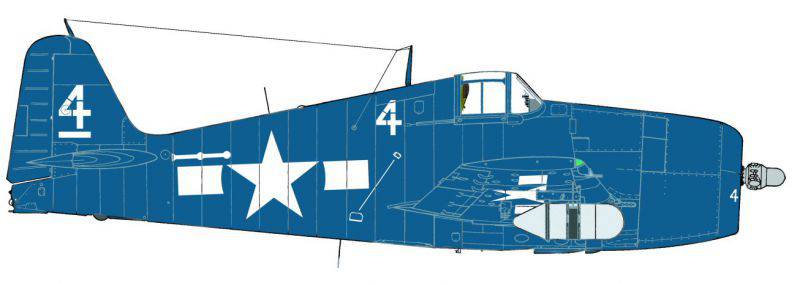
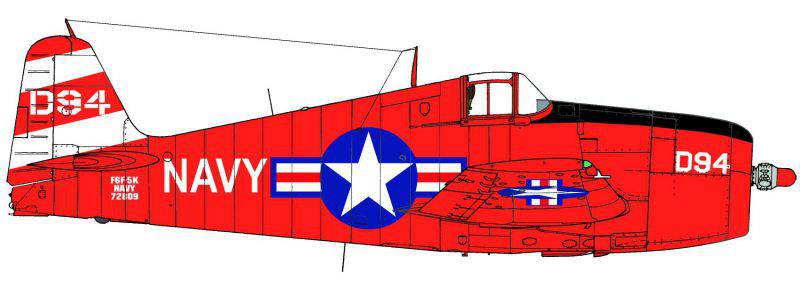
Information